|







|
. |
"Varmints"


 Recently the mail brought a report of a local conservation program that
impressed me as being very soundly conceived and competently executed. In
a quite extensive area, soil erosion had been checked, cover had been
re-established, and trees had been replanted. A wildlife area had been
created and much of the planting had followed the best precepts of wildlife
management and soil conservation.
Recently the mail brought a report of a local conservation program that
impressed me as being very soundly conceived and competently executed. In
a quite extensive area, soil erosion had been checked, cover had been
re-established, and trees had been replanted. A wildlife area had been
created and much of the planting had followed the best precepts of wildlife
management and soil conservation.

 Then, in discussing the problem created by an overabundance of foxes, it
was explained that the "varmints" were being trapped and exiled to distant
parts. The word "varmint" may have been only a passing concession to the
prejudices of some readers, but it cast doubt on the true orientation of the
entire program.
Then, in discussing the problem created by an overabundance of foxes, it
was explained that the "varmints" were being trapped and exiled to distant
parts. The word "varmint" may have been only a passing concession to the
prejudices of some readers, but it cast doubt on the true orientation of the
entire program.


 "Varmint" and "vermin" are words that have often been the sole moral and
biological justification for the misguided slaughter of hawks, owls, crows,
cormorants and other fish-eating birds, mountain lions, bears, wolves and
coyotes, foxes, racoons, mink, weasels, and snakes.
"Varmint" and "vermin" are words that have often been the sole moral and
biological justification for the misguided slaughter of hawks, owls, crows,
cormorants and other fish-eating birds, mountain lions, bears, wolves and
coyotes, foxes, racoons, mink, weasels, and snakes.

 The use of the terms "varmint" and "vermin" tells more about the speaker
than about the animals designated. It reveals that the speaker is prejudiced,
perhaps on the basis of hearsay, or perhaps from his own limited experience,
against the animal or its role in nature.
The use of the terms "varmint" and "vermin" tells more about the speaker
than about the animals designated. It reveals that the speaker is prejudiced,
perhaps on the basis of hearsay, or perhaps from his own limited experience,
against the animal or its role in nature.

 There is only one safe rule in approaching nature -- "Whatever is, is right."
The appearance of any form of life -- other than an introduced exotic -- is
evidence that there exists those environmental conditions and natural roles
for which the animal has been evolved by countless generations of natural
selection.
There is only one safe rule in approaching nature -- "Whatever is, is right."
The appearance of any form of life -- other than an introduced exotic -- is
evidence that there exists those environmental conditions and natural roles
for which the animal has been evolved by countless generations of natural
selection.




 No animal lives because it wilfully, perversely, and contrary to natural law,
decides to be alive. If this basic fact is recognized, the presence of
particular animals in such numbers that they become pests may serve as
illuminating "indicators". They are evidence that the environment has
changed, perhaps through man's activities, in ways to favor an unwanted
abundance of particular species.
No animal lives because it wilfully, perversely, and contrary to natural law,
decides to be alive. If this basic fact is recognized, the presence of
particular animals in such numbers that they become pests may serve as
illuminating "indicators". They are evidence that the environment has
changed, perhaps through man's activities, in ways to favor an unwanted
abundance of particular species.

 Similarly, the absence of desired wildlife, when individuals of that species
are present elsewhere, indicates that the local habitat lacks essential
features which that species seeks, or that individuals of that species have
not had time to establish traditions with respect to the area since it
became a suitable habitat.
Similarly, the absence of desired wildlife, when individuals of that species
are present elsewhere, indicates that the local habitat lacks essential
features which that species seeks, or that individuals of that species have
not had time to establish traditions with respect to the area since it
became a suitable habitat.

 The term "varmint" is commonly applied to predators. Yet, except in the rare
cases of predators preying on domestic livestock that cannot be protected,
predators cannot become too abundant. Predators can never increase
beyond the limits set by the available food supply. And since predators take
the easiest, most available prey, there is no danger that predation will
eliminate or unduly reduce any prey population. Predators, however
abundant, always adjust their numbers to the changing numbers of their prey.
The term "varmint" is commonly applied to predators. Yet, except in the rare
cases of predators preying on domestic livestock that cannot be protected,
predators cannot become too abundant. Predators can never increase
beyond the limits set by the available food supply. And since predators take
the easiest, most available prey, there is no danger that predation will
eliminate or unduly reduce any prey population. Predators, however
abundant, always adjust their numbers to the changing numbers of their prey.

 To designate any animal "vermin" is to confess that the speaker knows little
or nothing about the animal or its role in nature. Every animal has its
essential natural tasks; every animal discharges a vital natural function.
To ignore this is to invite trouble.
To designate any animal "vermin" is to confess that the speaker knows little
or nothing about the animal or its role in nature. Every animal has its
essential natural tasks; every animal discharges a vital natural function.
To ignore this is to invite trouble.

 The farmer who has resorted to heavy application of lethal insecticides has
killed myriads of beneficial insects along with the grasshoppers that
plundered his crops. He has paid a high future price in a less productive
soil, and prospects of a more troublesome insect problem in future years.
The farmer who has resorted to heavy application of lethal insecticides has
killed myriads of beneficial insects along with the grasshoppers that
plundered his crops. He has paid a high future price in a less productive
soil, and prospects of a more troublesome insect problem in future years.

 The plague of the grasshoppers might have been avoided if he had not, the
year before, resorted to the wholesale poisoning of field mice and other
small rodents, which probably also reduced the number of birds; both had
helped to keep grasshoppers and other insects within bounds.
The plague of the grasshoppers might have been avoided if he had not, the
year before, resorted to the wholesale poisoning of field mice and other
small rodents, which probably also reduced the number of birds; both had
helped to keep grasshoppers and other insects within bounds.

 And the rodent campaign would not have been necessary if the farmer had not
carried on a relentless shooting war against the hawks, owls, foxes and
skunks -- because he imagined that they were preying heavily on pheasants.
And the rodent campaign would not have been necessary if the farmer had not
carried on a relentless shooting war against the hawks, owls, foxes and
skunks -- because he imagined that they were preying heavily on pheasants.

 The balance which nature strikes is generally beneficent if man does not
blindly tilt the scales, but it can become costly and troublesome when
human interference seeks to favor or to prejudice one species without
knowledge of the ecological consequences.
The balance which nature strikes is generally beneficent if man does not
blindly tilt the scales, but it can become costly and troublesome when
human interference seeks to favor or to prejudice one species without
knowledge of the ecological consequences.


 Those who aspire to understand natural phenomena will accept every
designation of an animal as "vermin", or of a plant as "weed" as a challenge
to discover the natural role of the "vermin" or "weed". The inquiry will
probably lead to a discovery that fundamentally this is another instance of
man working against, rather than with nature.
Those who aspire to understand natural phenomena will accept every
designation of an animal as "vermin", or of a plant as "weed" as a challenge
to discover the natural role of the "vermin" or "weed". The inquiry will
probably lead to a discovery that fundamentally this is another instance of
man working against, rather than with nature.
There Are No "Varmints"
by Irston R. Barnes
from "WILDLIFE REVIEW"
Vol. IV, No. 4, Summer 1972
(Reprinted by Permission)

|
|

